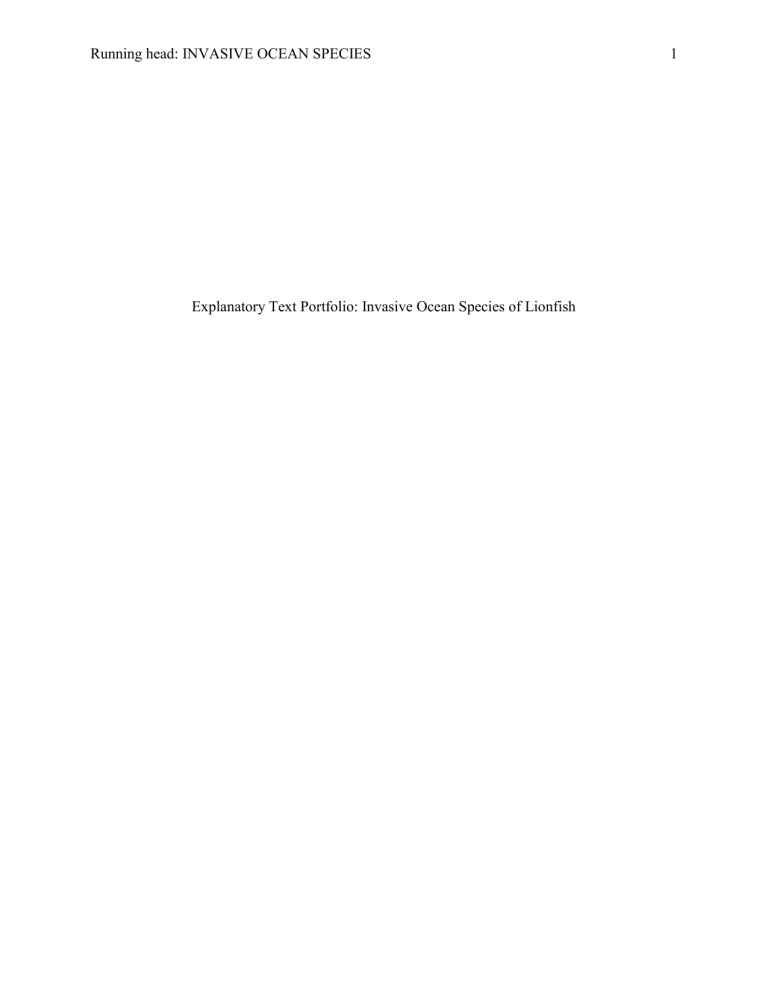
Running head: INVASIVE OCEAN SPECIES Explanatory Text Portfolio: Invasive Ocean Species of Lionfish 1 INVASIVE OCEAN SPECIES 2 Abstract An invasive ocean species is an ocean organism that causes ecological and/or economic damage in a new habitat where it is not native. Invasive ocean species can harm both the natural resources in an ecosystem as well as threaten human use and therefore economic benefit of these resources. One of the worst invasive ocean species is the lionfish that is capable of causing extinctions of native plants and animals, reducing biodiversity, competing with native organisms for limited resources, and altering habitats. INVASIVE OCEAN SPECIES 3 Explanatory Text Portfolio: Invasive Ocean Species of Lionfish One of the biggest ocean conservation threats worldwide are invasive species of organisms. The term “Invasive Species” is defined as organisms that have been introduced into an area where they aren’t native and are negatively impacting the ecosystem, the economy and/or human health, including accounting for $1.4 trillion in damage annually. In the United States alone, 42% of Threatened and Endangered Species are at risk due to invasives (Spencer, 2016). One of the most invasive species is the lionfish. Where It Came From Originally from the Indo-Pacific, the lionfish was introduced off the coast of South Florida in the mid-1980s and have since become one of the worst invasive marine species in the world. Lionfish are the “Hoover vacuums of the sea,” and large lionfish populations can eat up to a half a million prey fish per acre per year. Lionfish are a big threat to native fish in the Western Atlantic, Caribbean and Gulf of Mexico. As if that wasn’t enough, they also have a series of venomous spines that cause extreme pain and swelling if injected (National Oceanic and Atmospheric Administration, n.d.). How It Got Here The lionfish Atlantic invasion likely began in the 1980s or 1990s as a result of Florida people releasing them from domestic aquariums, although the exact way this occurred remains unverified while both institutional and home aquariums could have contributed with a mixture of intentional and accidental releases. Many marine species have been introduced in this way over the years, and aquariums commonly keep lionfish as specimens. Other means of introduction such as intentional stocking or ballast water releases seem unlikely based on current evidence. Once lionfish gained a foothold off the Florida coast, they spread eastward to Bermuda and INVASIVE OCEAN SPECIES 4 northward to North Carolina by way of ocean currents. They rapidly dispersed throughout the Caribbean region as well. With no natural predators in the invaded range and very high breeding rates (one female can spawn over 2 million eggs per year!), lionfish could easily colonize new areas. As of 2014, lionfish had reached as far as the Gulf of Mexico (Spencer, 2016a). “Gotta Eat ‘em to Beat ‘em” Fortunately, people are fighting back against the lionfish. Consistent local removal efforts can greatly reduce lionfish populations, allowing native fish to rebound. Lionfish also happen to be delicious, and many restaurants are adopting the “gotta eat ‘em to beat ‘em” campaign by serving the fish on their menus (Em’ to Beat Em’, n.d.). INVASIVE OCEAN SPECIES 5 References Eat Em’ to Beat Em’. (n.d.). Retrieved September 29, 2020, from https://www.reef.org/eat-embeat-em. National Oceanic and Atmospheric Administration. (n.d.). What is a lionfish? https://oceanservic e.noaa.gov/facts/lionfish-facts.html. Spencer, E. (2016, February 24). Lionfish: A Crash Course. https://oceanconservancy.org/ blog/2016/03/17/lionfish-a-crash-course/#:~:text=With%20no%20natural%20 predators%20in,favorite%20in%20the%20aquarium%20industry. Spencer, E. (2016a, February 24). The Ocean’s Least Wanted: 4 Invasive Species to Know. https://oceanconservancy.org/blog/2016/02/24/the-oceans-least-wanted-4-invasivespecies-to-know. INVASIVE OCEAN SPECIES 6 Figures Figure 1. A lionfish in an aquarium. Source: https://fishbio.com/field-notes/the-fishreport/lionfish-aquarium-fish-turned-marine-menace.



